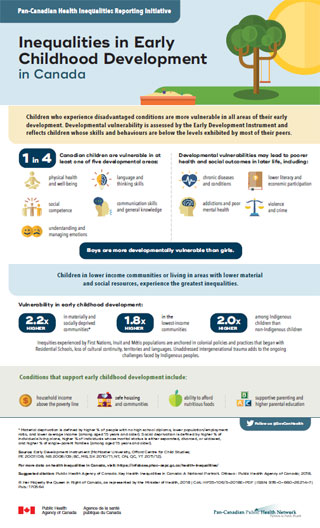Inequalities in Early Childhood Development in Canada - Infographic

Download the alternative format
(PDF format, 133 K, 1 page)
Organization: Public Health Agency of Canada
Published: 2018-05-30
Pan-Canadian Health Inequalities Reporting Initiative
Children who experience disadvantaged conditions are more vulnerable in all areas of their early development. Developmental vulnerability is assessed by the Early Development Instrument and reflects children whose skills and behaviours are below the levels exhibited by most of their peers.1 in 4 Canadian children are vulnerable in at least one of five developmental areas:
- physical health and well-being
- social competence
- language and thinking skills
- communication skills and general knowledge
- understanding and managing emotions
Developmental vulnerabilities may lead to poorer health and social outcomes in later life, including:
- chronic diseases and conditions
- addictions and poor mental health
- lower literacy and economic participation
- violence and crime
Boys are more developmentally vulnerable than girls.
Children in lower income communities or living in areas with lower material and social resources, experience the greatest inequalities.
Vulnerability in early childhood development:
- 2.2X higher in materially and socially deprived communities*
- 1.8X higher in the lowest-income communities
- 2.0X higher among Indigenous children than non-Indigenous children
Inequities experienced by First Nations, Inuit and Métis populations are anchored in colonial policies and practices that began with Residential Schools, loss of cultural continuity, territories and languages. Unaddressed intergenerational trauma adds to the ongoing challenges faced by Indigenous peoples.
Conditions that support early childhood development include:
- household income above the poverty line
- safe housing and communities
- ability to afford nutritious foods
- supportive parenting and higher parental education
Follow us @GovCanHealth
* Material deprivation is defined by higher % of people with no high school diploma, lower population/employment ratio, and lower average income (among aged 15 years and older). Social deprivation is defined by higher % of individuals living alone, higher % of individuals whose marital status is either separated, divorced, or widowed, and higher % of single-parent families (among aged 15 years and older).
Source: Early Development Instrument (McMaster University, O-ord Centre for Child Studies;
PE 2007/08; NB 2008/09; BC, MB, SK 2010/11; NT, ON, QC, YT 2011/12).
For more data on health inequalities in Canada, visit: https://infobase.phac-aspc.gc.ca/health-inequalities/
Suggested citation: Public Health Agency of Canada. Key Health Inequalities in Canada: A National Portrait. Ottawa : Public Health Agency of Canada; 2018.
©Her Majesty the Queen in Right of Canada, as represented by the Minister of Health, 2018 | Cat.: HP35-106/5-2018E-PDF | ISBN: 978-0-660-26214-7 |
Pub.: 170564